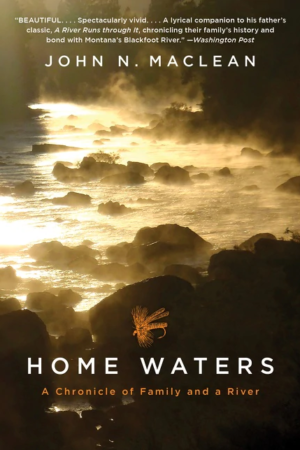Home Waters
by John N. Maclean
reviewed by Henry Hughes
John N. Maclean begins his memoir fly fishing on Montana’s Big Blackfoot River. Many years earlier, he had asked his father, Norman, why they no longer fished that stretch of river. His father had explained that it was because he didn’t know the new landowner, but the son also claims that his father “held many memories close, in a kind of time vault, to be reshaped and burnished without the nuisance of updates.”
Every memoirist reshapes and burnishes; John N. Maclean also updates, revisits, and researches in this informative, engaging, and affectionate chronicle about his father, the writer Norman Maclean (1902–1990) and his 1976 bestseller, A River Runs Through It and Other Stories. The title novella is widely considered one of the greatest fishing stories of all time, and like all great fishing stories—think of work by Chekhov, Maupassant, Hemingway, Carver, and Proulx—angling becomes a metaphor for the art of living. The elder Maclean’s moving and largely autobiographical story pivots on the character of his charismatic brother, Paul, a master fly fisherman who can’t control his drinking and gambling and is beaten to death and dumped in a back alley at the age of thirty-two.
In Home Waters, Maclean traces the genesis of his father’s remarkable book though familial and regional history. The Macleans lived in Missoula, Montana, and kept a cabin fifty-five miles away on Seeley Lake that stayed in the family even after Norman took a faculty position at the University of Chicago and, years later, his son moved to Washington, D.C., to serve as a correspondent for the Chicago Tribune. Maclean’s prose is sharp and clear, not surprising for a veteran journalist and author of several works of nonfiction on wildfires, most notably Fire on the Mountain.
There are three things to remember about Montana, his father would say—“timber, fishing and fire”—and much of Home Waters focuses on these features, enhanced by the book’s illustrations, wood engravings in fine linear tint by Wesley W. Bates. The author revisits the Blackfoot River, discoursing on Native American life, the Lewis and Clark Expedition, the amazing trout fishing it provided the Maclean family in the 1920s and 1930s, and the degradation it eventually suffered due to mining and logging. A River Runs Through It, both the book and 1992 film directed by Robert Redford, brought mixed blessings to its home waters, attracting more anglers and boaters, but also raising awareness that promoted catch-and-release practices, cleanups, tributary restoration, and dam removal.
In 1921, five decades before A River Runs Through It, Norman Maclean left the sticks to attend Dartmouth College, where he heard long lectures by Robert Frost (who “wasn’t interested in the thoughts of undergraduates”), edited the college’s humor magazine with his close friend Theodor Geisel (who would soon adopt the pen name Dr. Seuss), and developed into a literary scholar with a specialization in Shakespeare and the British Romantics. In 1928, Norman became a teaching assistant at the University of Chicago, where he worked for twelve years on his doctorate and then became, by all accounts, a beloved professor, dedicated much more to his students than to publishing and professional advancement. A three-year stint as dean of students during World War II gave him an ulcer: “he’d hated most having to kick kids out of school for academic failure,’” and he happily returned to the classroom. “He knew he’d made the right move,” his son relays, “when his stomach settled down enough that he ‘could switch from scotch and milk back to bourbon and ditch.’”
Professor Maclean published little more than his revised dissertation and three articles. The big story was brewing within. At seventy, he retired from teaching and began drafting stories, eventually sending out a manuscript that was rejected by two major houses; the editor at Knopf said it was “a nice book but not a saleable book.” The University of Chicago Press took a gamble on the book, its first venture in fiction, and at the age of seventy-four, Norman published A River Runs Through It and Other Stories. It received praise from the New York Review of Books, New York Times, Newsweek, Publishers Weekly, and the Chicago Sun-Times, and was a finalist for the Pulitzer Prize. In the realm of angling literature, it’s “a masterpiece,” as Nick Lyons declared in Fly Fisherman magazine.
Though Norman Maclean wrote a great book late in life, his second attempt at the feat—a nonfiction account of the Mann Gulch wildfire of 1949—was an agonizing slog. “After struggling for several years, he handed a draft manuscript of the book to his first editor, Allen Fitchen, who told him frankly that he’d made a hash of it.” His son is vague about how much assistance he and subsequent editors provided to the manuscript, but Young Men and Fire was published posthumously in 1992 and received the National Book Critics Circle Award.
Home Waters ends as it began, on the Big Blackfoot River, where the fly-fishing author lands and releases the largest rainbow trout he has ever seen on that river: “Strobe-like images of a fish’s glaring eye, an iridescent strip of scarlet, and a salmon-sized head flashed in my mind’s eye.” These images carry us back through haunted generational waters and those spectacular, once-in-a-lifetime catches—be it a fish or a book—that inscribe our modest marks on history.
Published on June 14, 2022

